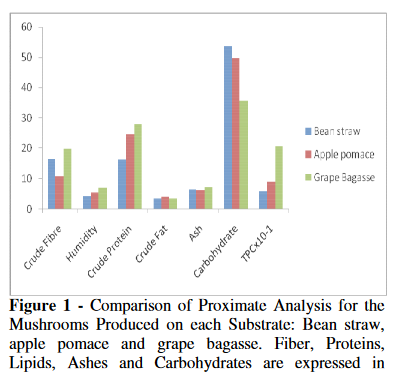Determining the basic composition and total phenolic compounds of Pleurotus sajor-caju cultivated in three different substrates by solid state bioprocess
DOI:
https://doi.org/10.20873/jbb.uft.cemaf.v3n2.pazKeywords:
Pleurotus sajor - caju, nutritional composition, oyster mushroom, phenolic compounds, grape bagasse, apple pomaceAbstract
Oyster mushrooms (Pleurotus sajor-caju) were grown in grape bagasse, apple pomace or bean straw. Samples were taken for each one of the substrates and analyzed for moisture, ash, carbohydrate, crude fat, crude fiber, crude protein content and total phenolic compounds. The substrate affected all the parameter content and mainly the total phenolic compounds. In general, the nutritional aspects of mushrooms produced using grape bagasse tended to be better. Changes in the total phenolic compound content of the fruit could be explained by the biosorption capacity from substrate. It was possible to confirm that composition depends on cultivation substrate.
References
AOAC, (1990), Official Methods of Analysis, 14th ed.; Association of Official Analytical Chemists: Washington, DC.
Asolini, F. C.; Tedesco, A. M.; Carpes, S. T.; Ferraz, C.; Alencar, S. M. (2006), Atividade Antioxidante e Antibacteriana dos Compostos Fenólicos dos Extratos de Plantas Usadas como Chás. Brazilian Journal of Food Technology, 9, 209-215.
Badalyan, S. M. (2003), Edible and Medicinal Higher Basidiomycetes Mushrooms as a Source of Natural Antioxidants. International Journal of Medicinal Mushrooms, 5, 153-163.
Devrajan, A.; Joshil, V. K.; Gupta, K.; Sheikher, C.; Lal, B. B. (2004), Evaluation of Apple Pomace Based Reconstituted Feed in Rats After Solid State Fermentation and Ethanol Recovery. Brazilian Archives of Biology and Technology, 47, 93-106.
Lakshmi, B.; Jose, N.; Ajith, T.; Janardhanan, K. K. (2004), Antimutagenic Activity of Methanolic Extract of Culinary-Medicinal Oyster mushroom, Pleurotus ostreatus (Jacq.:Fr.) Kumm. (strain florida Eger nom. nud.) and Its Protective Effect Against Benzo [a] Pyrene-Induced Hepatic Damages. International Journal of Medicinal Mushrooms, 6, 139-150.
Manzi, P.; Marconi, S.; Guzzi, A.; Pizzoferrato, L. (2004), Commercial mushrooms: nutritional quality and effect of cooking. Food Chemistry, 84, 201-206.
Mattila, P.; Salo-Väänänen, P.; Konko, K.; Aro, H.; Jalava, T. (2002), Basic Composition and Amino Acid Contents of Mushrooms Cultivated in Finland. Journal of Agricultural Food Chemistry, 50, 6419-6422.
Mizuno, T. and Zhuang, C. (1995), Houbitake, Pleurotus sajor-caju: antitumor activity and utilization. Food Review International, 11, 185-187.
Ngai, P. H. K. and Ng, T. B. (2004), A ribonuclease with antimicrobial, antimitogenic and antiproliferative activities from the edible mushroom Pleurotus sajor-caju. Peptides, 25, 11-17.
Paz, M. F.; Vieira, E.; Breyer, C. A.; Giovanni, R. N.; Bertoldi, F. C. (2006), Cultivo de Pleurotus sajor-caju em bagaço de uva Isabel. Evidência, 6, 187-194.
Ramos, A. C.; Sapata, M. M.; Candeias, M.; Figueiredo, E.; Gomes, M. L. (2003), Cultura de Cogumelos do Gênero Pleurotus. Portugal: INIAP, 605-611.
Silva, S. O.; Costa, S. M. G.; Clemente E. (2002), Chemical composition of Pleurotus pulmonarius (Fr.) Quél., substrates and residue after cultivation. Brazilian Archives of Biology and Biotechnology, 45, 531-535.
Tam, S. C.; Yip, K. P.; Fung, K. P.; Chang, S. T. (1986), Hypotensive and renal effects of an extract of the edible mushroom Pleurotus sajor-caju. Life Science, 38, 155-1161.
Tambekar, D. H.; Sonar, T. P.; Khodke, M. V.; Khante, B. S. (2006), The novel antibacterials from two edible mushrooms: Agaricus bisporus and Pleurotus sajor caju. International Journal of Pharmacology, 2, 584-587.
Villas-Bôas, S. G.; Esposito, E.; Mendonça, M. M. (2003), Bioconversion of apple pomace into a nutritionally enriched substrate by Candida utilis and Pleurotus ostreatus. World Journal of Microbiology and Biotechnology, 19, 461-467.
Yang, J. H.; Ching-Lin, H.; Mau, J.-L. (2001), Non-volatile taste components of several commercial mushrooms. Food Chemistry, 72, 465-471.
Ragunathan, R.; Gurusamy, R.; Palaniswamy, M.; Swaminathan, K. (1996), Cultivation of Pleurotus spp. on various agro-residues, Food Chemistry, 55, 139-144.

Published
How to Cite
Issue
Section
License
Copyright (c) 2024 - Journal of Biotechnology and Biodiversity

This work is licensed under a Creative Commons Attribution 4.0 International License.
Authors who publish with this journal agree to the following terms:
Authors retain copyright and grant the journal right of first publication with the work simultaneously licensed under a Creative Commons Attribution License (CC BY 4.0 at http://creativecommons.org/licenses/by/4.0/) that allows others to share the work with an acknowledgement of the work's authorship and initial publication in this journal.
Authors are able to enter into separate, additional contractual arrangements for the non-exclusive distribution of the journal's published version of the work (e.g., post it to an institutional repository or publish it in a book), with an acknowledgement of its initial publication in this journal.
Authors are permitted and encouraged to post their work online (e.g. in institutional repositories or on their website) prior to and during the submission process, as it can lead to productive exchanges, as well as earlier and greater citation of published work (Available at The Effect of Open Access, at http://opcit.eprints.org/oacitation-biblio.html).


